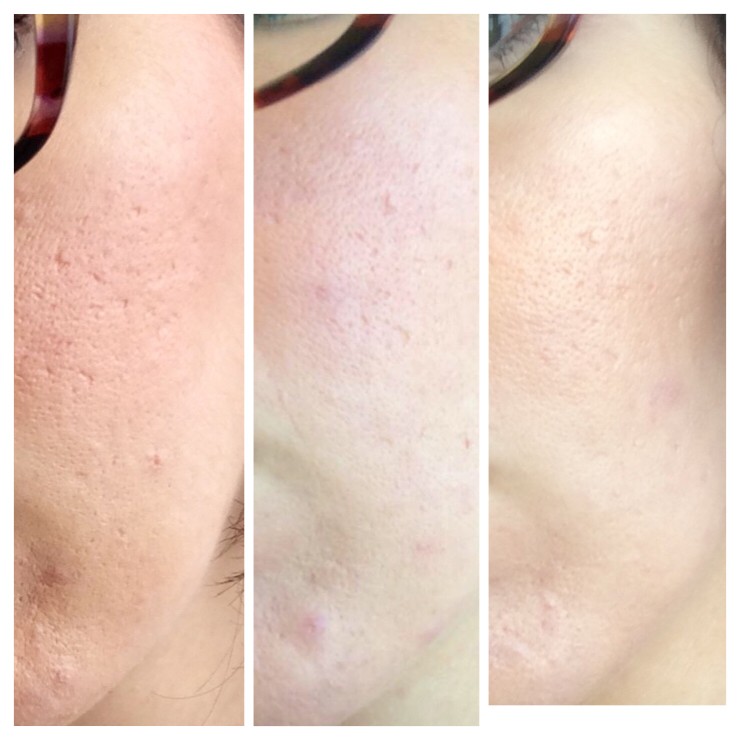- TCA stands for trichloroacetic acid and is used as a noninvasive treatment to address photodamaged skin, wrinkles, acne scars, and discolorations.
- Researchers found that TCA peels have more potent and longer-lasting results than glycolic, lactic, and salicylic acid peels.
- TCA peels can be tailored to most people’s needs in the hands of a good dermatologist and are suitable for all types of skin.
Everyone dreams of that picture-perfect skin we so often see in Hollywood, and without a doubt, exfoliation is the key step to achieving it. Luckily, today’s skincare world comes up with an amalgam of treatments in terms of exfoliation: microdermabrasion, the dreaded St. Ives scrub, crazy pore-sucking vacuums, and of course, our beloved AHAs (alpha-hydroxy acids) and BHAs (beta-hydroxy acids).
But what if gentler exfoliators don’t solve your skin concerns? If AHA or BHA peels haven’t brought you the desired results, there’s a new acid in town that should be on your radar: trichloroacetic acid (THA). Interestingly, researchers found that TCA peels have more potent and longer-lasting results than other chemical acids and can go deeper into the skin’s layers. Besides, dermatologists have used them for over 50 years and still tout them as age-old skin perfecters. With that kind of a longstanding reputation, you know it must bring some serious results.
What is TCA peel?
TCA, or trichloroacetic acid, is an in-office chemical peel that targets diverse skincare needs. It addresses skin concerns such as fine lines and wrinkles, uneven skin tone, acne, and hyperpigmentation.[1][2][3][4] TCA peel works by penetrating deeper into the epidermal layers and causing a controlled injury to the skin, which stimulates collagen production and cell renewal. This leads to a reduction in the appearance of fine lines and wrinkles and an overall improvement in the texture and tone of the skin.
The name may sound a little intense, but this acid isn’t too different from the others you’ve used. TCA is made from acetic acid, the stuff that gives vinegar its wallop. The difference is that TCA peels are much stronger and often more concentrated than what you can find in OTC products. Serums with 2% salicylic acid or 10% glycolic acid can be used daily, and even the chemical peels you can get from a facialist can be done every one to two weeks. These weaker acids need a more frequent application, but since TCA is more powerful, you’ll usually see significant results after fewer sessions.
What is a TCA peel good for?
Ask any dermatologist, and they’ll say TCA peels are good at everything. Used to treat almost every skin condition, from sunspots, wrinkles, uneven texture, and acne scars, and even to lighten tattoos, TCA peels are an essential part of every dermatologist’s toolkit.[1][2]
The versatility of TCA peels comes from the ability to use varying concentrations for depths of peel targeting different concerns. There are three levels of facial peels, with strength varying based on your goals. The mildest ones, superficial peels, have a lower concentration, safer for typical spa days. These brighten your skin and help soften texture issues. They also treat minor breakouts, smooth fine lines, and improve sun-damaged skin.
However. the stronger intensity is where trichloroacetic acid really shines! With the supervision of a professional, medium-depth TCA peels can treat deeper acne scars, wrinkles, and brown spots. For deeper peels, TCA is usually combined with other exfoliants (like Jessner’s solution) to target more stubborn problems.[5] Deeper TCA peels benefit those with severe acne and icepick scars. High concentrations of TCA, up to 70%, can be applied to scarring using something called the CROSS technique — a procedure that involves using high concentrations of TCA solution onto the surface of the atrophic scar.[6] Generally, this gives really good results especially when other treatments haven’t worked.[7]
In short, TCA peels are ideal for treating less-inflamed acne and age spots, reducing scarring, and improving skin texture and radiance.[1][2]
Who can use TCA peel?
TCA peels can be tailored to most people’s needs in the hands of a good dermatologist. If you have darker skin, be careful before getting a TCA peel because of the increased risk of scarring and hyperpigmentation, so discuss it with a professional beforehand. The same goes if you have super sensitive skin or are using products like retinol. But rest assured because most doctors perform a spot test to ensure you don’t have a bad reaction to the peel.
Who is TCA peel not good for?
A study suggests that some people are more likely to experience complications after TCA peels and should act more cautiously:
- People with darker skin tones with a tendency to develop post-inflammatory hyperpigmentation.
- People with sensitive skin or a history of atopic dermatitis.
- People with dry skin.
- People that spent a lot of time outdoors.
- People with a history of photosensitivity.
- People with a history of poor wound healing or herpes infection.
- People who have recently taken isotretinoin.
- People who are psychologically disturbed.
How are TCA peels performed?
TCA peels are done in a professional office, where your dermatologist or aesthetician will discuss your goals and provide some before and aftercare. During your appointment, trichloroacetic acid is applied to the skin for about 30 minutes, after which the solution is no longer active. After the treatment, the doctor may recommend applying a healing ointment with antibacterial properties for the following week to help the skin recover and reduce the chances of bacterial infections.
Your skin may look a little scary at first, but the signs of redness should reduce after a week. The deeper a peel goes, the longer the recovery time between the old skin peeling and your new baby’s smooth skin. Give your skin time to heal. This is not a treatment for the day before vacation.
What to expect
The procedure is typically performed by a licensed skincare professional and takes anywhere from 15 to 45 minutes, depending on the strength of the peel and the area being treated. Before the procedure, the doctor will thoroughly clean the skin, usually with acetone, to remove all impurities so that the acid can penetrate deeper into the skin and work more effectively. Then, it will apply the TCA to the skin using a brush or cotton swab, and leave it on for a specific amount of time.
During the procedure, you may feel a stinging or burning sensation, which is normal. After the doctor removes the solution, your skin may feel tight and dry and will have a frosted white or gray appearance.
After the peel, it’s essential to follow the aftercare instructions provided by your dermatologist, which may include using a cream, avoiding sun exposure, and applying sunscreen. The skin peeling process can start anywhere from 2 to 7 days after the procedure and can last for up to a week. The new skin will be more delicate and sensitive, so avoiding using harsh products or picking at the peeling skin is important.
Redditor’s results after a TCA peel

How much do TCA peels cost?
The cost of a TCA peel can vary depending on the location, the practitioner’s experience, and the depth of the peeling solution. On average, the cost of a TCA peel ranges from $150 to $800 per treatment. However, it’s not uncommon to see TCA peel costs $1,500 or more.
Can you do TCA peels at home?
Although you can do a TCA peel at home, professionals advise against it. I, too, highly advise visiting a licensed dermatologist or clinical aesthetician, as TCA peels require professional medical supervision.
TCA peel vs. glycolic acid
TCA peels are often compared to glycolic acid in the dermatological field, but really there is no clear-cut way of deciding which is better. The decision is up to you or your healthcare provider.
Multiple comparative studies have shown that TCA peels give similar results to glycolic acid or Jessner peels for the treatment of photodamaged skin, wrinkles, acne scars, and hyperpigmentation.[2][4][8] However, there’s a big difference in the concentration used for each peeling solution in those studies. TCA peels have shown similar benefits at a significantly lower concentration than glycolic acid, wherein in some studies, the concentration of TCA peel was even three times lower than that used for glycolic acid. This suggests trichloroacetic acid is more potent than glycolic acid and addresses more severe skin conditions.
Side effects of TCA peels
As with all chemical peels, TCA peels are not free of side effects. They temporarily damage the skin and leave it dry, tight, and irritated for the following week. This is normal, and these side effects usually go away on their own once the skin is recovered. You can also apply a regenerative cream to alleviate these adverse effects and accelerate healing. Also, as I already mentioned, medium-to-depth TCA peels can increase the risk of hyperpigmentation and scarring in people with darker tones. To reduce this risk, apply sun protection every morning.
Final words
If you want to enjoy the benefits of chemical peels, you should definitely consider talking to your doctor about getting a TCA peel. Unlike other facial peels, TCA goes deeper into the skin to encourage the natural process of cell renewal. It may work even better than your beloved glycolic acid peel to treat skin discoloration, age marks, scars, uneven texture, and blemishes.
Footnotes
Women’s Concepts uses reliable sources, including dermatologists’ insights, clinical trials, and scientific journals, to find accurate information and support all the facts shared in our articles. All statements and claims have clear and legit references. Read our editorial policy to learn more about our sources of information, our process of researching and fact-checking the content, and how our team strives to keep all articles updated, completed, and trustworthy.
- Fanous, N. et al. (2017). Universal Trichloroacetic Acid Peel Technique for Light and Dark Skin. JAMA facial plastic surgery, 19(3), 212–219. doi:10.1001/jamafacial.2016.1666
- Kubiak, M. Et al. (2014). Evaluation of 70% Glycolic Peels Versus 15% Trichloroacetic Peels for the Treatment of Photodamaged Facial Skin in Aging Women. Dermatologic Surgery, 40(8), 883–891. doi:10.1097/01.dss.0000452669.84787.bf
- Farber, George et al. (1984) Update on Chemical Peel, The Journal of Dermatologic Surgery and Oncology. 10( 7) , 559-560 doi: 10.1111/j.1524-4725.1984.tb01252.x
- Puri, Neerja, et al. (2015). Efficacy of Modified Jessner’s Peel and 20% TCA Versus 20% TCA Peel Alone for the Treatment of Acne Scars. Journal of cutaneous and aesthetic surgery, 8(1), 42-5. doi:10.4103/0974-2077.155082
- Abdel-Meguid, et al. (2017). Combined Jessner Solution and Trichloroacetic Acid Versus Trichloroacetic Acid Alone in the Treatment of Melasma in Dark-Skinned Patients. Dermatologic Surgery, 43(5), 651–656. doi:10.1097/dss.0000000000001036
- Agarwal, N., Gupta, L. K., Khare, A. K., Kuldeep, C. M., & Mittal, A. (2015). Therapeutic Response of 70% Trichloroacetic Acid CROSS in Atrophic Acne Scars. Dermatologic Surgery, 41(5), 597–604. ncbi.nlm.nih.gov/pubmed/25899884
- Bhardwaj, D., & Khunger, N. (2010). An Assessment of the Efficacy and Safety of CROSS Technique with 100% TCA in the Management of Ice Pick Acne Scars. Journal of cutaneous and aesthetic surgery, 3(2), 93–96. doi:10.4103/0974-2077.69020
- Puri N. Comparative study of 15% TCA peel versus 35% glycolic acid peel for the treatment of melasma. Indian Dermatol Online J. 2012.


